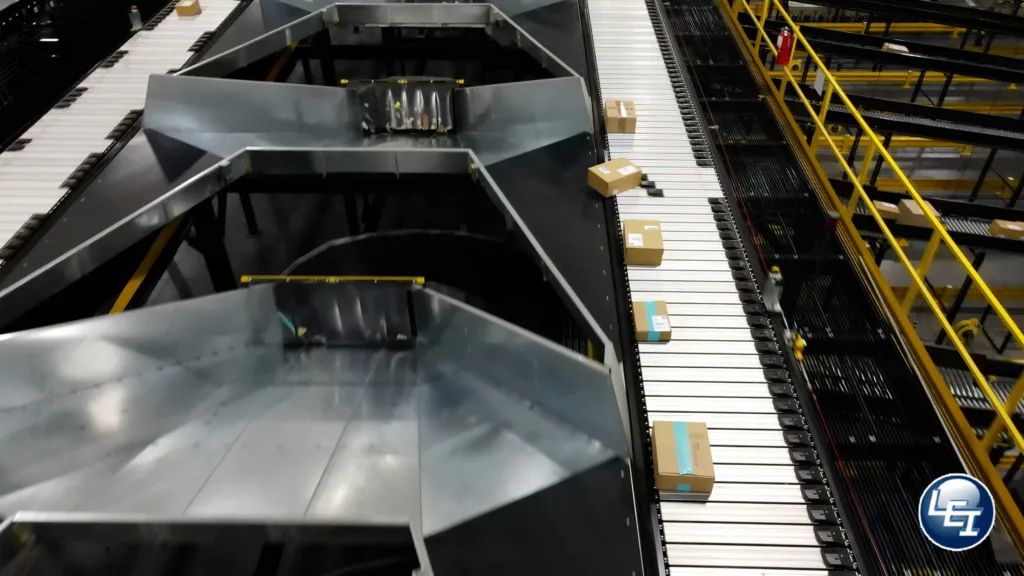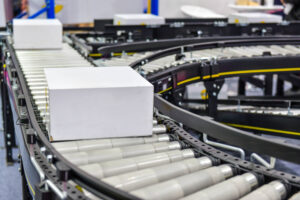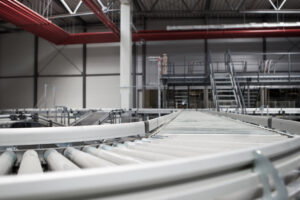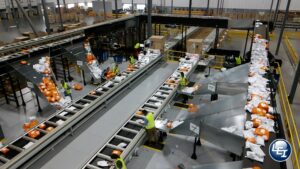Table of Contents
Lafayette Engineering is a leading provider of industrial conveyor systems, including High-Speed Merge Conveyor, with a reputation for designing and manufacturing innovative solutions that optimize production lines. Their expertise spans a wide range of conveyor applications, including sorting, picking and packing, high-speed merge conveyor, racking, and printing and labeling. In this blog post, we’ll delve into the world of high-speed merging, a crucial aspect of many production processes.

What is a High-Speed Merge Conveyor?
A merge conveyor, as the name suggests, is a conveyor system designed to seamlessly combine products from multiple infeed lines into a single, unified output line. This consolidation of product streams is essential for various applications, such as feeding packaging equipment, assembly lines, or further processing stations. By effectively merging product flows, manufacturers can achieve increased production efficiency and throughput.
Different Types of High-Speed Merge Conveyors
Lafayette Engineering offers a comprehensive selection of merge conveyors to cater to diverse production line requirements. Here’s a closer look at the four primary types of merge conveyors:
- Sawtooth Mergers:
- Sawtooth mergers are renowned for their ability to handle the most significant number of infeed lines. They feature a unique sawtooth design that incorporates a series of angled sections that gradually merge product streams from multiple infeeds into a single output lane.
- Advantages:
- Superior capacity for handling numerous infeed lines.
- Efficient merging of high product volumes.
- Considerations:
- May require a larger footprint compared to other merge conveyor types.
- Might not be the most suitable option for applications with limited space constraints.
- Live Roller Mergers:
- Live roller mergers employ a series of powered rollers that continuously rotate, ensuring smooth product transfer from infeed lines to the main output conveyor. This type of merge conveyor excels in applications that require precise product control and minimal product accumulation at the merge point.
- Advantages:
- Precise product handling and minimal accumulation.
- Suitable for delicate or fragile products.
- Considerations:
- Live roller mergers may have a higher initial cost compared to some other merge conveyor options.
- Regular maintenance is required to ensure optimal performance of the powered rollers.
- Belt Mergers:
- Belt mergers utilize a single, continuous belt to merge product streams from infeeds onto the main output conveyor. They are a popular choice for high-speed applications due to their ability to handle large product volumes efficiently.
- Advantages:
- Ideal for high-speed merging applications.
- Offers a smooth and efficient product transfer process.
- Considerations:
- Belt mergers might not be the most suitable option for products that require precise control or positioning at the merge point.
- Belt maintenance is crucial to ensure proper product tracking and prevent product slippage.
- Spur Mergers:
- Spur mergers are a cost-effective solution for merging product streams. They typically consist of short sections of conveyor that branch off from the main output line and merge with the infeed lines at an angle.
- Advantages:
- Most economical option among the different merge conveyor types.
- Simple design that requires minimal maintenance.
- Considerations:
- Spur mergers may not be suitable for high-speed applications or large product volumes.
- Product accumulation can occur at the merge point due to the angled infeed sections.
Choosing the Right Merge Conveyor for Your Needs
The selection of the optimal merge conveyor for your production line hinges on several critical factors:
- Number of infeed lines: Consider the number of product streams you need to merge. Sawtooth mergers are ideal for a high number of infeeds, while spur mergers might be sufficient for just a few infeeds.
- Product type and characteristics: The size, weight, and fragility of your products will influence your choice. Live roller mergers are well-suited for delicate products, while belt mergers can handle larger or heavier items.
- Production speed: For high-speed merging, belt mergers are often the preferred option.
- Space constraints: The available footprint in your production line will determine the feasibility of certain merge conveyor types. Sawtooth mergers tend to have a larger footprint, while spur mergers are more compact.
- Budget: Spur mergers are generally the most cost-effective option, while live roller mergers may have a higher initial cost.
By carefully evaluating these factors and consulting with a qualified conveyor system expert, you can select the most appropriate merge conveyor to optimize your production line’s efficiency and throughput.
In addition to the core merge conveyor types discussed above, Lafayette Engineering offers a variety of specialized merge conveyor solutions to address specific production line challenges. These may include:
- Merge conveyors with integrated buffering systems: These systems provide temporary storage
Follow Us on Linkedin



